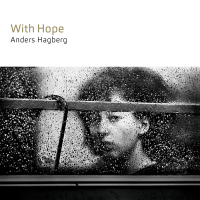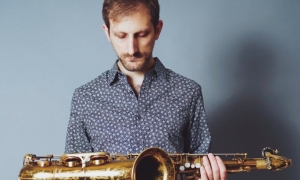Home » Jazz Articles » Interview » Frank London: The Jew with the Horn
Frank London: The Jew with the Horn
Our producer, Christoph Borkowsky Akbar, challenged us: 'I want to hear you guys, but put more of your lives, New York, an urban young sound in Klezmer.'
 Frank London is one of the most interesting and colorful figures in the current revival of Jewish music—mistakenly identified only as Klezmer music—of the last two decades. London seeks consciously and constantly to expand the terminology and vocabulary of Jewish music with groups including Hasidic New Wave, Shekinah Big Band and Klezmer Brass All-Stars. The Klezmatics won a 2006 best World Music Grammy Award for its versions of Woody Guthrie songs on Wonder Wheel (Jewish Music Group, 2006). "It was a very important milestone for Jewish music, acknowledging Jewish music in a very official way as part of the canon of World music, said London. But London is also known for injecting a healthy dose of free jazz aesthetic and energy while addressing current political agendas, controversial issues and speaking openly about his left-of-center politics.
Frank London is one of the most interesting and colorful figures in the current revival of Jewish music—mistakenly identified only as Klezmer music—of the last two decades. London seeks consciously and constantly to expand the terminology and vocabulary of Jewish music with groups including Hasidic New Wave, Shekinah Big Band and Klezmer Brass All-Stars. The Klezmatics won a 2006 best World Music Grammy Award for its versions of Woody Guthrie songs on Wonder Wheel (Jewish Music Group, 2006). "It was a very important milestone for Jewish music, acknowledging Jewish music in a very official way as part of the canon of World music, said London. But London is also known for injecting a healthy dose of free jazz aesthetic and energy while addressing current political agendas, controversial issues and speaking openly about his left-of-center politics.
This interview with London was conducted in Jerusalem, where he performed with the Israeli AndraLaMoussia Ensemble at the Jewish Music Days festival in early September, 2007. London reflects on his growing interest in Jewish music, culture and many traditions, as well his politics.
London begins with two of his many endeavors that combine music and politics. In 1999 London led the fusion-meets-Klezmer ("Sun Ra meets Jimi Hendrix at a Jewish wedding, as they called it) Hasidic New Wave, rewriting an updated version of the Dead Kennedys' punk anthem "California Ãœber Alles. That Dead Kennedys song referenced the anthem of Nazi Germany, and mocked Jerry Brown, the new-agey governor of California. London's version, "Giuliani Ãœber Alles, dedicated to the former mayor of New York, was written after he personally experienced the brutality of New York policemen. That version appeared on Hasidic New Wave's Kabalogy (Knitting Factory, 1999), and London still thinks that the song and the message are relevant, especially in the current presidential campaign.
All About Jazz: Will Hassidic New Wave perform this song during the presidential campaign?
FL: We played several times last year, but nothing is planned. Now that we have YouTube and wholesome computer animation, I'm looking for an animator. If you hear or read me now out there, take my recording, take this important anti-Guiliani song so relevant to this campaign, and put it out there. I'm sure many will see it.
Likewise, three years ago I had an idea about the infamous and horrible US prison in Guantánamo that represents a violation of international law and the Geneva Convention by imprisoning and torturing people there. People forget that the beautiful, gorgeous song "Guantanamera is about people coming from Guantánamo. So I talked to my colleagues, who have a Latin-hip-hop-Jewish band, the Hip Hop Hoodios , and said, "Let's do a hip-hop remake of the song as an anti-Guantánamo protest song, 'Viva la Guantanamera,' and use it as a fund-raiser for Amnesty International, and they did it with a lot of rappers. I did the arrangement and the trumpet solo, and Lorin Sklamberg from the Klezmatics sang a verse.
 AAJ: How did you begin playing Jewish Music?
AAJ: How did you begin playing Jewish Music?
FL: I'm almost fifty now. Now my background feels like I was in my twenties and thirties. I grew up in a very suburban area near New York in a very typical American reform Jewish household, so musically there was nothing interesting at all. There was a tiny little drop of Jewish music, Mickey Katz, but it was one of his jokes on American pop songs. I did not realize that it was Jewish. The music in the synagogues was horrible—nothing interesting musically.
I did not encounter anything of interest about Jewish music until my twenties, but the same is true of everything else. I was into rock, Frank Zappa forever. In my late teens I began to discover jazz and improvisation, and in my first year in college where there was a music department, I met a guy who was jazz saxophonist, Gary Shore, who was obsessed with jazz. We spent hours and hours listening and playing. I started listening obsessively to Lee Morgan and Booker Little, and later to Don Cherry, Mongezi Feza and Lester Bowie, all the history of jazz trumpet and all the bebop and avant-garde. Cherry, Feza, and Bowie are my strongest influences and models. Each is related to his own traditions. Feza took South African folk songs and played them as free jazz, like I did with the Hasidic New Wave.
It was the time of Black Liberation. So they hired this saxophone guy, Brother Ah, better known as Robert Northern, who played on John Coltrane's Africa/Brass Sessions (Impulse!, 1961) and Charlie Haden's original Liberation Music Orchestra (Impulse!, 1969), and he taught a course on "Sound Awareness, Free Improvisation and African Roots of Free Improvisation. That got me headed into more open thinking. And from there I went to the New England Conservatory of Music, and there I began to discover all the other music of the world—Klezmer, Latin, African, brass music and two or three years later we started the Klezmer Conservatory Band in Boston, and that's how I began to study this music.
AAJ: Were you aware at that time that you want to do more than play just tradition-based music?
FL: If you look at the history of this music in America, it was very strong in the twenties and thirties of the twentieth century, and than it changed, it became more American, less important. It was commercialized, and we began to discover it in the late seventies and play it again. So we studied the original recordings of the twenties—Dave Tarras and Abe Schwartz—for The Klezmer Conservatory Band. We were young and very aggressive musicians, and but the leader was more concerned about the old way.
I moved to New York around 1985, and I was still learning, liked the music and I wanted to do it more. And than we put together the Klezmatics. We did not say that, "Now we are getting it more modern, or, "not our father's Klezmer, as we were published [as saying] at the time. We were doing the same things, but it was more a choice of repertoire. We stripped away many things that indulged Jewish music that we did not like. All the schmaltz, kitschy nostalgia, the corny elements, all the Fiddler on the Roof. These songs had a great strong tradition of socialist Yiddish, social activism and love, not only about remembering the Old World. We chose our songs based on the repertoire; interesting songs.
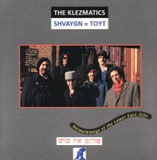
I learned a lesson from Charles Mingus and Sun Ra. There is a distinction between rhetoric around an art and the art itself. At best you can integrate it. You can create the myth, create your intentions and, of course, we sure had political artistic consciousness, even if the music was not literally connected to it .We called our first record Shvaygn=Toyt (Rounder/ Piranha, 1988), which in Yiddish is Silence=Death. A very political title, which reflected what we believed and it still does, an AIDS activism slogan, but also a statement about speaking out when people are trying to be quiet. All the things together. And even if the music was not yet radicalized, the intention and perception was.
We started as being very traditional, most of the lyrics were a hundred years old, but our choice of what tradition to present was different. This is the Jewish Yiddish tradition, beautiful songs that say a lot about our situation; protest music. You don't have to sound like Fiddler on the Roof or Giora Feidman. In a sense we were lying. It was our grandparents' Klezmer music. Our parents' Klezmer became more conservative and schmaltzy. There was a bit of radicalism our version of "Alle Brider [a traditional ad-lib Yiddish Socialist cry for unity and celebration that became the Klezmatics' signature anthem from their first concerts], where we added a verse about gays, a nice provocative line: "We all brothers, we all sisters, we all gay, like Jonathan and King David because it rhymes beautifully. We played on the double meaning of freylekh. In Yiddish it is literally gay and happy and freylekh is also the name of the dance and the rhythm.
Our producer, Christoph Borkowsky Akbar from Piranha, challenged us. "I want to hear you guys, he said. "I will put out an album, no problem, but put more of your lives, New York, an urban young sound in Klezmer. It was the first time that it came to us as a conscious choice that we could do what we really wanted to do. Our second album, even tougher in many ways, is not our best but maybe the most important, Rhythm + Jews (Rounder/ Piranha, 1990).
On Rhythm + Jews there were twenty ways that you could take this tradition and move it forward, and it became like kind of a guidebook for us and for many other people. You could add free improvisation, Arabic music, rock ballad, this rhythmic or harmonic device, sound, all based on this traditional music. It still stands up, because unfortunately it began the whole movement of really corny puns on Jewish music. This was our response to the Borkowsky question: where can you go with it? And you can say that we spent the next twenty years working out the possibilities.
AAJ: Did Rhythm + Jews mark the beginning of the revival of Jewish Music as we know it through Tzadik's Radical Jewish Culture series?
FL: If you look again at history, in the eighties when I first discovered this music, we were learning and establishing it, and in the early nineties something new happened. The Klezmatics began to open up, to play from the inside, and people came from outside jazz, and than you got the feeling that something was happening all over the States, Europe, everywhere, maybe not yet in Israel. The experimentation began. In 1992 I played with John Zorn on Kristalnacht (Tzadik, 1995), Zorn curated the Radical Jewish Culture days in Munich, and the Knitting Factory smelled the trend in the air and put together the Jewish Alternative Movement discs.
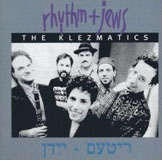 AAJ: In retrospect, don't you think that some of the output of Zorn and the Tzadik releases or Knitting Factory's Jewish Alternative Movement were nothing more than more codified and formalized versions of what the Klezmatics and other bands began to explore? How many of these recordings will stand the test of time?
AAJ: In retrospect, don't you think that some of the output of Zorn and the Tzadik releases or Knitting Factory's Jewish Alternative Movement were nothing more than more codified and formalized versions of what the Klezmatics and other bands began to explore? How many of these recordings will stand the test of time?
FL: These are someone's marketing terms. For me it was very organic thing. I was playing jazz, improvisational music, World music, Jewish music. It made natural sense for it all to come together.
If I've had any influence on other people, I feel blessed. The point was to be honest. When Jewish people come up to us and thank us for what we have done, for enriching their ability to celebrate their lives as Jews, as gays; and likewise, when non-Jewish musicians and artists come to us say that our work gave them inspiration how to work with their traditions. We did not try to make a text that you were forced to follow, but a text that you would have to work out for your self.
Many of these recordings will stand out for different reasons. Marty Ehrlich's because he is an interesting composer and Anthony Coleman because he has such a unique approach to jazz history. Not because they are Radical Jewish. It may seem from the outside that it's become a formula, but who cares? I am more disappointed that more people have not tried to follow their own identity and, instead, followed a trend, a formula. Nine times out of ten it's boring. The tenth time is interesting when someone develops it, gets it right, figures it out.
It does not affect my path, which is to integrate my musicality, my own aesthetics, my politics. I've found that the process of learning old traditions, and applying different aesthetics, processes and critiques to that, interests me and suits who I am. It is so hard to do something that stands out outside of tradition. The musical traditions and vocabularies are so strong, that we can come as friends, jesters and enemies, and challenge them, live with them and see how we can work with them. I love the strength and ethos of traditions, set on community and spirituality, and you don't have to reject them but you can embrace and engage with them, have a dialogue with them.
Tradition is not supposed to be a hammer that hits you on your head. I am so deeply committed to tradition—Jewish or jazz traditions—our rabbis are Abraham, Joshua, Mongezi Feza, Don Cherry and HaBaal Shem Tov. We learn from these rabbis. Sure, you have your iconoclasts, such as La Monte Young, Bill Dixon, Mark Rothko and James Joyce; maybe they that did not spend time imitating their predecessors, but they were aware of the connection.
For many of us, some are Jews where Judaism is part of our lives and for others it's not, and some are not Jews. We don't sit talking about the Judaism in the movement, we'd rather be doing the music. But it's interesting. In Hasidic New Wave my partner Greg Wall became an orthodox and now he is a rabbi, and in the Klezmatics my partner and buddy Lorin Sklamberg is deeply Jewish, culturally and religiously, but in a way that is separate from me, partially because he's gay. We are all connected in different ways with mutual respect, even our rejections are connected with love.
align=center>![Frank London ></br> Frank London at The Jewish Culture Festival in Krakow, Poland 2007 </p><br /><br /><P><strong>AAJ:</strong> For you the new Jewish music has always something to say about the current world and its politics, not only about the tradition.<br /><br /><P><strong>FL:</strong> And vice versa. It's not only about looking at my tradition, because I have a problem with nationalist identification, saying this is our identity, our tradition at the expense of who we are as human beings. I'm an open, liberal, humanist person who absolutely believes in universal rights but it's not only a Jewish discourse.<br /><br /><P><br /><br />I think about how to show the commonality in music, the respect of working together, like when I come together with [Palestinian oud player] <A HREF= http://www.simonshaheen.com/ TARGET=_blank>Simon Shaeen </A> because of the close proximity of Jewish and Arabic music and our related cultures, or Boban Markovi', where it's about very similar and interrelated cultures—Eastern European Jewish music and Eastern European Gypsy music—or <A HREF=http://www2s.biglobe.ne.jp/~Libra/ TARGET=_blank>Natsuki Tamura, </A>, with whom I'm going to play at the Festival of New Trumpet Music, and who comes from free jazz. We come as individuals and multi-faceted personalities, acknowledging the complexities of our identities finding ways how the music can work together.<br /><br /><P><br /><br />It's similar to what we did with Hasidic New Wave. All—Wall, guitarist David Fiuczynsky, bassist Fima Ephron and drummer Aaron Alexander—are just so strong players like in the late Mingus quintets, with so much energy, and everything is filtered through the Jewish music. We were doing so very consciously—for the game, for the learning. Like a song I wrote,](/photos/2007/franklondon_3.jpg) nign, we did a cross between freylekh and a James Brown rhythm with a bass line, but tried not to make it a formula. "Spirit of Jew-Jew [all from From The Belly Of Abraham (Knitting Factory, 2001)] is a clear reference to Wayne Shorter and Archie Shepp, so all the influences came in a very unique way.
nign, we did a cross between freylekh and a James Brown rhythm with a bass line, but tried not to make it a formula. "Spirit of Jew-Jew [all from From The Belly Of Abraham (Knitting Factory, 2001)] is a clear reference to Wayne Shorter and Archie Shepp, so all the influences came in a very unique way.
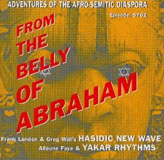
My identity and music, as Jewish, is true but also it is just a sub-division. Being Jewish became more important in my life and my family, that's why I am interested and so involved with so many aspects of Jewish music—the cantorial hazònos, Hasidic nigunim, for example—but I am now studying Arabic music, makams, Ethiopian music and, recently, German folk songs; and I love it so much.
AAJ: Tell me more about your fascination with the Jewish cantorial music, hazònos.
FL: My dream is to find how the original Jewish music of Israel, the cantorial music of the temple, represented a musical continuity through the years to the deepest shtetl in Eastern Europe. To look at what the late cantor of Egypt, Moshe Eliahu, or the chief cantor of the Israeli Andalusian Orchestra, Emil Zrihan, do and reestablish its connection and construction to East European cantorial music. I'm trying to explore ideas all the time. It is one of many ways to go for the future.
My recordings Invocations (Tzadik, 2000) and Hazònos (Tzadik, 2005) are sketchbooks. Each of them were done in one day—I explained the concept to the musicians and "gp. The idea was East European cantorial music, which I began to listen to five years ago. I knew the connection of Hazònos to Hassidic songs and Klezmer, but did not know what it was. I hated every thing I heard, often because of the practices, like bad operatic performances.
What broke the ice was when Hankus Netsky, from the Klezmer Conservatory Band, gave me a recording from 1912 of "Avinu Malkenu, from the Yom Kipur service, and it's an amazing piece of music that gave me all sorts of inspiration. It's an open form that reminds me of Bill Dixon, in a sense of the openness of space and time. Time is not dictated by a beat, but by a text. In the voice of the great cantors, not the operatic ones, you can feel the connection to Old World, muezzins, Eastern world, music of pre-Diaspora Judaism, all the elements spread there. It is so open and challenging and ties back to the early AACM solo instrument concerts.
So I began to transcribe the solos of great cantors, David Rosenblatt, for Invocations, and thought, "What I can do with it? How can the trumpet sound like a voice, how can the two harmoniums slightly suggested a Pakistani Kawali sound without going there, and how can the church organs that we use in synagogues and, obviously, Albert Ayler be implied as the cantor rather than stated. You can hear what Milford Graves would have done through the whole record, without him being there.
Hazònos came from a soundtrack that I did for a documentary on cantor Jacob Mendelsson, The Cantor Tale. These are the great prayers from the slichos prayers of Yom Kipur. Their structure is so simple, build to a climax and than resolve very quickly. The high point of that record is an instrumental free jazz piece, "Repentance, that follows one of the prayers, and shows my personal attachment to this music and where it's going.
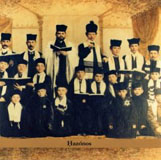
This is a belief I have about spiritual Jewish music, about spiritual music and about music. Often with Jewish Music—and I mean Jewish through the text and the singing or specific musical tradition—in countless recordings of Jewish music from the twenties the accompanying music is very pop—swing, disco, whatever it is, it's just sort of generic. Countless Hassidic recordings, to which I listen only to learn the lyrics, are really bad. But every accompanying instrument has to have the same spiritual intensity, a meaning, kavana, that the lead voice has, and than you create a coherent all, a spiritual integrity, a connection to spirituality. Like on Albert Ayler's first records. That's the idea on Hazònos; we were working from the inside to really elevate the performances, that are all working in a very deep way, and it is less important if it is coming from Ashkenazi Jewish music, or outside influences such as free jazz, Pakistani Kawali music, classical—all are possibilities. It's not been done until now.
A lot of what I do in all my work, I study the structure, how it works. The ontology of music is contained not only in individual harmonies, melodies and rhythms, but in the way instrumental sounds are combined with the structure. If you talk about ontology of bebop and the Blue Note quintets that Horace Silver or Art Blakey embody. So when I look for models for Eastern European Hazònos music I look for Om Kalsoum and Nusrat Fateh Ali Khan, and I want to study where rhythm comes and goes in those structures.
AAJ: What are your coming projects?
FL: For the last twenty-eight years I've been working on Klezmer and Yiddish songs, for the last fifteen years with Hasidic songs, and for the last five years with Hazònos. I love music beyond music as such, as part of political structure and in conjunction with different arts, dance and theater. I worked a lot on theater music. Lately I've been thinking about Yiddish theater; again how this deep, deep culture with so much essential art, aesthetic, politics and music, became nothing more than mindless, nostalgic, unimportant stuff. I started to think about it ten years ago. My last album, A Night In The Old Marketplace (Soundbrush, 2007), is based on a hundred year-old play by Y. L. Peretz. It's music theater and I'm clearly referencing all the traditions of Yiddish theater music, but again, in the same manner of the Klezmatics, getting rid of the kitschy elements, the nostalgic elements. I'm trying to integrate and open it up, as I did with Klezmer and Hassidic and Jewish brass music.
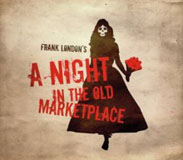
I'm going to make three albums, two of German music. One is German folk songs that my wife Tine sings. I've been asked to reinvent German Oktoberfest and beer songs with a brass band. It's fun and we are going to get rid of all their kitschy elements. I'm aware of the connection between kitsch aesthetics and fascism, and in Germany, where the history is so alive, I'll do anything that can help them embrace their culture, but be critical and anti-fascist. We are going to find songs with good revolutionary texts, Hans Eisler, Jewish writers. And the third, I'm going to take the Klezmer Brass All-Stars, and I'm going to do a Hasidic dance record, with women singing traditional Hasidic songs with electronic rhythms.
But I want to tell you about the highlight of my summer. Music is about energy, creativity, and how far you can push yourself as an individual and how deep you can go to achieve a greater statement in music. Albert Ayler, Charlie Parker and Charles Mingus asked the same thing. But on the other hand, as much as I hate kitsch, I love spectacles, but it's difficult philosophically because mass spectacles are akin to fascism, and you always have to remind people in the moment of mass group ecstasy—that almost mystical transformation where through the group all become one, and you are dancing and singing and you're losing your sense of self identity—that it's fantastic, but you have to be careful about it. It leaves us with personal responsibility. How can we have both, without losing our morals? This is why rational Jews are at odds with mystical Jews. So much of what I'm doing is going between these poles, and I don't have an answer, except that I'm aware of it. Spectacle as a kind of anti-spectacle.

So I was in the annual Jewish Culture Festival in Krakow, Poland, and it always culminates in a concert in the town square, in the old Jewish quarter. More than ten thousand people were there, from six in the afternoon till early in the morning. I did my Carnival Conspiracy project, and instead of my Brazilian percussionists I used a group of percussionists from Warsaw who play Brazilian music. I had sixteen musicians onstage, all the musicians of the festival, not only Klezmer musicians but also with screaming electric rock guitar, Latin drummers, a black rapper, musicians from Nigeria and Germany, cantor, all to the grand finale, at 1:30 in the morning. We knew that all the crowd knew the popular song "Numa Numa and we added the lyrics of Rabbi Nachman of Breslov, "Na Nach Nachma Nachman Meuman." It was a weird mix of cultural influences, total spectacle, totally insane, and we kept playing it on and on until the police told us to shut down the sound system so we began a parade. We were very high at the end of it.
Selected Discography
Frank London, A Night In The Old Marketplace (Soundbrush, 2007)
Frank London, Divan (Frank London, 2007)
Paul Brody, For The Moment (Tzadik, 2007)
Klezmatics, Wonder Wheel (with lyrics by Woody Guthrie) (Jewish Music Group, 2006)
Frank London's Klezmer Brass All-Stars, Carnival Conspiracy (Piranha, 2005)
Klezmatics, Brother Moses Smote The Water (Piranha, 2005)
Frank London, Hazònos (Tzadik, 2005)
Aaron Alexander, Midrash Mish Mosh (Tzadik, 2004)
Klezmatics, Woody Guthrie's Happy Joyous Hanuka (Klezmatics, 2004)
David Yengibarjan, Pandukht (Budapest Music Center, 2003)
Marc Ribot, Filmworks 2 (Tzadik, 2003)
Frank London's Klezmer Brass All-Stars, Brotherhood of Brass (Piranha, 2002)
Klezmatics, Rise Up! Shetyl Oyf! (Rounder/ Piranha, 2002)
Wolf Krakowski, Goyrl : Destiny (Tzadik, 2002)
Frank London, Invocations (Tzadik, 2000)
Hasidic New Wave, Kabalogy (Knitting Factory, 1999)
Ballin' The Jack, Jungle (Knitting Factory, 1999)
Klezmatics, The Well, A Collaboration with Chava Alberstein (Rounder, 1998)
Frank London/ Lorin Sklamberg/ Uri Caine, Nigunim (Tzadik, 1998)
Hasidic New Wave, Psycho-Semitic (Knitting Factory, 1998)
Hasidic New Wave, Jews And The Abstract Truth (Knitting Factory, 1997)
Frank London, The Debt (Tzadik, 1997)
Klezmatics, Jews With Horns (Rounder/ Piranha, 1995)
Frank London, Music From The Movie The Shvitz (Knitting Factory, 1995)
John Zorn, Kristallnacht (Tzadik, 1995)
Photo Credit
Top and Bottom Photos: Nir Shaanani
Group Photo: Pawel Mazur, courtesy of the Jewish Culture Festival in Krakow, Poland
Tags
PREVIOUS / NEXT
Support All About Jazz
 All About Jazz has been a pillar of jazz since 1995, championing it as an art form and, more importantly, supporting the musicians who make it. Our enduring commitment has made "AAJ" one of the most culturally important websites of its kind, read by hundreds of thousands of fans, musicians and industry figures every month.
All About Jazz has been a pillar of jazz since 1995, championing it as an art form and, more importantly, supporting the musicians who make it. Our enduring commitment has made "AAJ" one of the most culturally important websites of its kind, read by hundreds of thousands of fans, musicians and industry figures every month.









